Given the van’s unusual structure, caravan stability might come off as a challenge when how to load your van. It is important to keep your caravan stability while on the road. Incorrectly loaded caravans can and do cause accidents. Having a well-balanced van is the trick to avoiding this from happening to you. Let me show you here how to properly load your van and have a safe trip.
BLOG CONTENTS
The principle behind proper caravan loading
Calculating for the balance of your van loading
What do tow capacities have to do with loading your van?
Design criteria for caravan stability
Definitions of weight terminologies
How to load your van
Some caravan manufacturers state in their Owner’s manuals how to load their caravans. That’s your number one priority reference when learning how to load your van. Otherwise, the main tips I can give you are:
- Place your stuff as near as possible to the axle(s), and
- If you have plenty of stuff, load the heavier items near the axle(s)
- Should you have both front and rear axles, evenly distribute your loads to both axles
The principle behind proper caravan loading
Not all of us love Physics, so I’ll explain it to you in an engaging way (as much as possible, that is). Imagine carrying a shoulder bag, first in the ‘normal’ way – which is, letting it hang on your shoulder. Now imagine carrying that same shoulder bag using your hand instead. Which one is easier?


Naturally, the first case is much easier. That is because you have placed the load nearer to your reference point (your shoulder). That is the principle of “work”. The nearer you place your load to your reference point, the less amount of work you will have to exert.
Work = mass x distance
The case is the same when loading your caravan. Your reference points are your axles. Therefore, you must place your stuff as near as possible to your axles. However, there are factors to consider other than placement. These are balance, load limits and towing conditions. Read on to know more about how these factors affect caravan stability.
Calculating for the balance of your van loading
We have just learned that it’s preferable to load appliances as near as possible to the axle(s). But let’s look at a bigger picture now. How can you actually say that your loading is overall balanced? To answer this question, you have a bit of calculation to do. Take a look at this illustration:
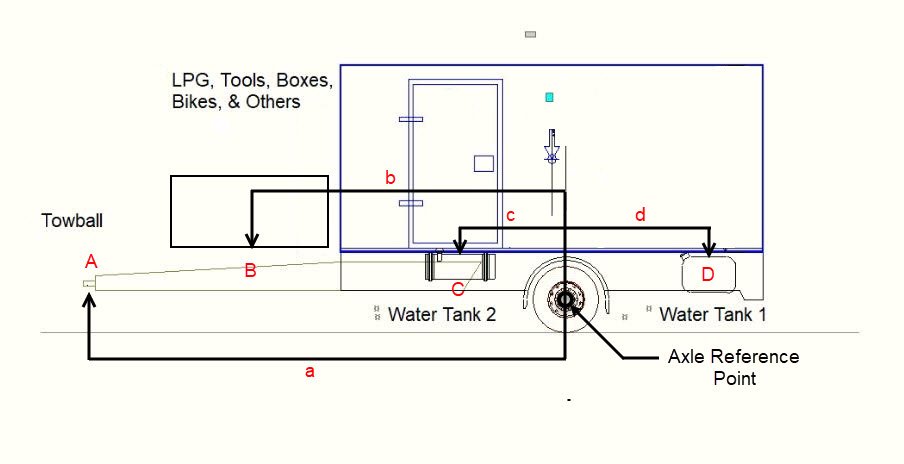
Along the reference point (axle), all ‘clockwise’ loads must be balanced with ‘counter-clockwise’ loads. When we analyse the figure above and simplify it as shown below (imagine your reference point as a hinge),
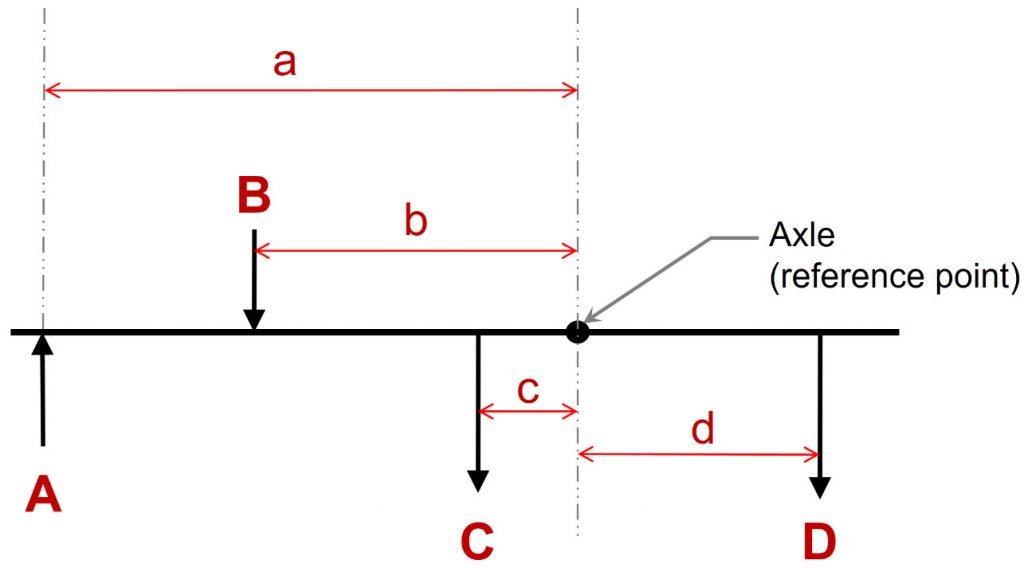
- ‘B’ and ‘C’ are counter-clockwise forces because they tend to cause the horizontal bar to turn counter-clockwise
- ‘A’ and ‘D’ are clockwise forces because they tend to cause the horizontal bar to turn clockwise
Now if we apply these forces into the formula for ‘work’ above, we get what we call ‘moment’ (instead of ‘work’). That is because we are now considering the rotational directions of these forces (i.e. torque).
Tow ball loading is extremely critical as it contributes to the overall load of a vehicle-caravan tow combination. Hence, it must be accounted for as well when assessing caravan stability.
We need to know the ball loading which is the weight that will be imposed on the towball of the towing vehicle. As much as possible, we want the ball loading to be close to zero.
Sample calculation
| A = ? | a = 1.5m |
| B = 10kg | b = 1.3m |
| C = 15kg | c = 0.2m |
| D = 20kg | d = 0.5m |
Solution:
Counter-clockwise ‘moment’ = Clockwise ‘moment’
(B x b) + (C x c) = (A x a) + (D x d)
(10kg x 1.3m) + (15kg x 0.2m) = (A x 1.5m) + (20kg x 0.5m)
A = +4kg
Therefore, you are overall imposing +4kg of weight on the towball.
What do we do with this figure then? You have to compare this calculated loading (A) with the manufacturer-specified maximum loading of the towball. It must be within such limit. But then again, it’s better if it’s close to zero – this is where rearranging your stuff comes in.
In computing for the balance of your caravan, include all items to be loaded plus the weights of your fluids (water, LPG, etc.).
Recognising load limits
The three main weights that matter the most in vehicles (and in caravans) are:
- Its empty weight (‘tare mass’)
- The weight of its standard equipment/facilities inside, and
- The maximum weight that it is allowed to further carry (i.e. for passengers, luggage and extra equipment) – this is the payload
Payload = Aggregate trailer mass (ATM) – tare mass
Out of the three above, you should find at least two of these on your compliance plate.
It is critical to ensure proper distribution of payload over all the axles of your caravan. Under or overloading axles loads can result in poor vehicle performance and handling characteristics, and in some cases cause accidents.
Discussing payload distribution is important because it affects how seats, equipment and facilities must be located within your vehicle. Hence, it’s a critical factor to consider both when modifying or building your RV and when loading it up for your trips, so be cautious.
What do tow capacities have to do with loading your van?
As briefly introduced earlier, loading your caravan does not mean you only have to look at the loading limit of the caravan itself. Since it has to be eventually towed on the road in order to complete your RV experience, the load limits of the tow coupling and tow vehicle must be accounted for as well.
In other terms, the weight which your caravan imposes on the ground when unhitched is different from the weight it imposes when it is hitched. Your payload changes as well. Therefore, you have to somehow recalculate your tow limits including payload.
It is worth noting that determining your actual tow limit can get tricky. The key here is to know how to calculate for your overall actual tow limit. That way, you can calculate for your new payload.
Sample calculation
You find your tow vehicle, tow coupling and caravan to have the following data:
| TOW COUPLING | TOW VEHICLE | CARAVAN | ||
| Capacity = 2500kg | GVM | 4000kg | ATM | 2300kg |
| GCM | 6000kg | GTM | 2100kg | |
| Towbar rating | 3000kg | Tare mass | 1300kg | |
| Towball rating | 3500kg | |||
Originally your caravan payload is:
Payload = ATM – tare mass = 2300 – 1300 = 1000kg
But that is only applicable when the caravan is standing by itself. If we hitch it to your tow vehicle, we’ll have to factor in the tow capacities of your tow vehicle and tow coupling. This is where we have to calculate the actual overall limit of your vehicle-caravan combination.
- On the tow vehicle, GTM = GCM – GVM = 2000kg. This means that the maximum GTM which the tow vehicle can handle is only 2000kg.
- Compare the values in red above. Clearly, the tow vehicle GTM limit is the least of them. Therefore, your overall tow limit is 2000kg. So how does it affect your caravan payload? Continue on.
- Knowing that GTM = payload + tyre load, a decrease of 100kg in GTM limit means you have to either:
-
- Decrease by 100kg the stuff you are to put in your caravan, or
- Rearrange your stuff such that the 100kg decrease in GTM is effected
-
- To make it easier for you, you can actually load your stuff and weigh your GCM on a public weighbridge. After that, the only thing you have to do is to compare the measurement with the GCM rating of the tow vehicle. The measurement must be within the said rating.
Still finding it confusing? Then here’s a treat:
Van and vehicle weight and balance calculator
Rob Landore, through RV Daily Magazine, has provided a spreadsheet calculator which may help you in determining your caravan stability. Plus, this tool is capable of showing you if a particular load placement is within your actual limits. What a relief! And the most important benefit you can get from this is that you can learn more about the concept of weight & balance by playing around with some figures. So how does it work?
Enter all important data on the green cells. On the right table, you will see how much load is being distributed for each part of your van.
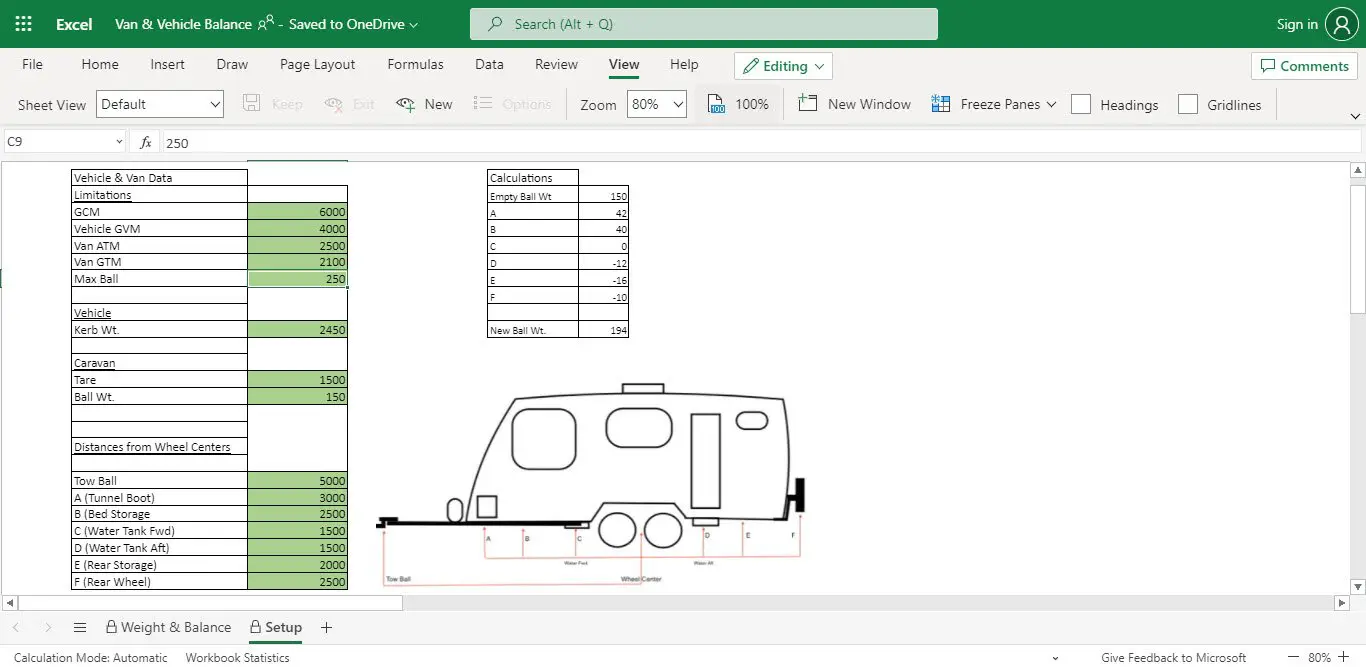
Proceed to the Weight and Balance tab shown on the bottom part of the image below. There you must enter on the green cells how much load you want to put in specific parts of your vehicle and van.
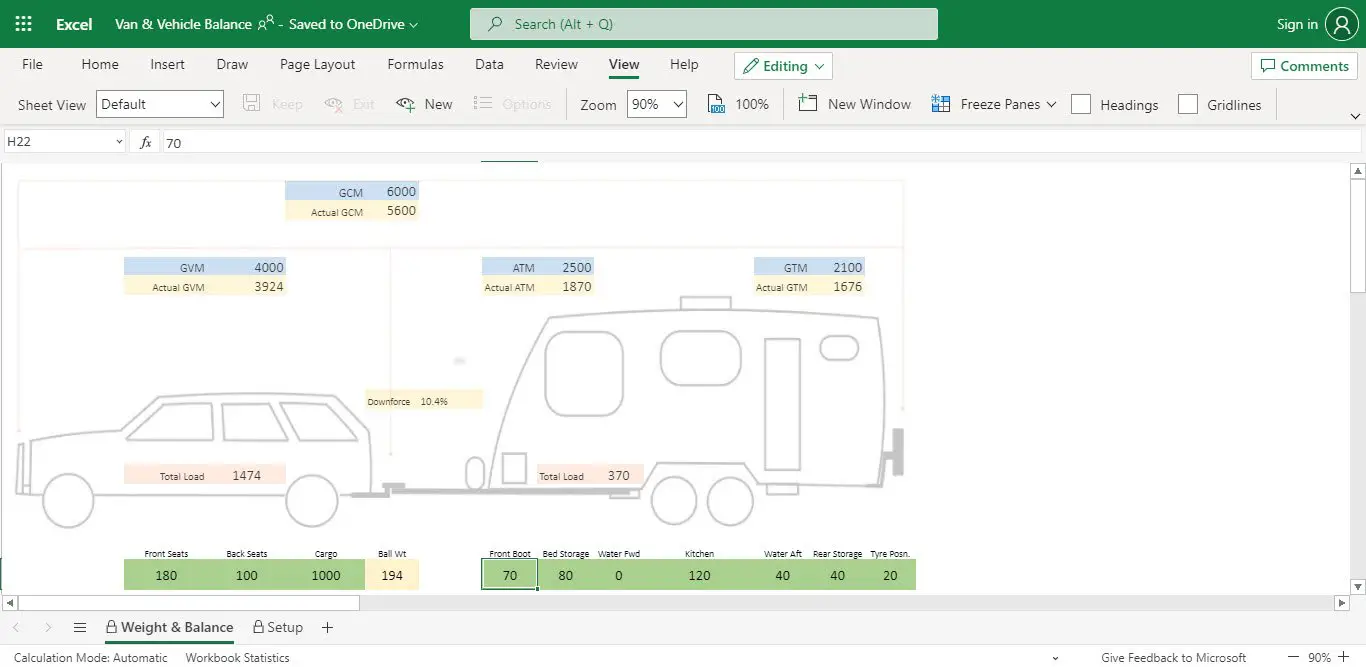
In case you have overloaded your vehicle or your van on any load point, a red text will appear saying “Overloaded“. Cool tool, right?
Design criteria for caravan stability
How do manufacturers determines caravan stability is enough? In terms of engineering design, caravans must meet these main performance criteria regardless of how much it is loaded (as long as it is within its ATM rating):
- The caravan does not shake or sway
- The caravan rides well
To ensure that the above are met, engineers do some primary calculations and compare the results with the standard limits. Upon confirming that it’s up to standard, they draw up the caravan including all its components and fittings. After that, they conduct a calculation check followed by any minor drawing revision. All these are done using application software such as:
- CAD (Computer-aided design),
- CAM (Computer-aided manufacturing), and
- CAE (Computer-aided engineering) among others
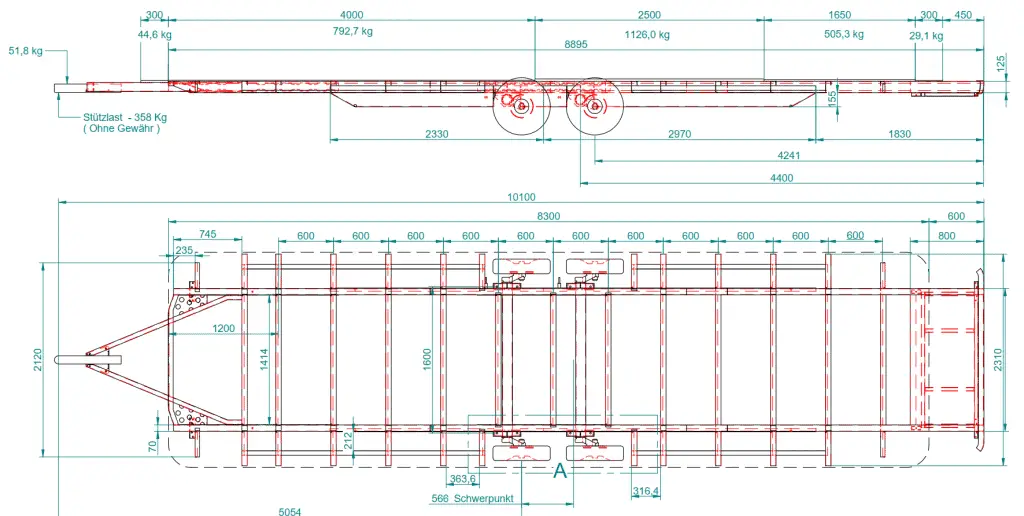
Of course, it doesn’t stop there. A reality check is needed, that is why actual tests are done after constructing a sample model of the designed caravan. That is where the assessors check the caravan’s actual performance in accordance with the above criteria. When everything’s proven to be up to standard, the design now is ready for mass production.
Definitions of weight terminologies
I’ve listed here some loading terms usually used by caravanners, and their definitions in a somehow simpler manner. But to know more weight terminologies (and their definitions) usually used in the RV industry as a whole, visit my list of these. Definitions there are simplified as well, so do check it out.
Aggregate Trailer Mass (ATM)
On the condition that the trailer is NOT attached, the ATM is the sum of the following:
- mass of the unoccupied trailer,
- maximum load recommended by the manufacturer, and
- any mass that may be imposed onto the towing vehicle upon attaching the trailer
As much as GVM is important for motor vehicles, so is ATM to trailers.
Axle Load
The total load (or weight, if that helps you understand better) carried by the road as a result of the weights transferred by the tyres attached to that axle. Also, the centres of the wheels of that axle must be less than 1 metre apart to be classed as a single axle.
Gross Combination Mass (GCM)
“Combination” means the setup consisting of a towing vehicle and the trailer it tows. With that in mind, you can better understand the GCM as the sum of the following:
- The GVM of the towing vehicle, and
- The sum of the axle loads of the trailer to be towed
The manufacturer specifies the GCM.
Gross Trailer Mass (GTM)
Hitch first the trailer before calculating for the GTM in accordance to this equation:
GTM = A + B
where:
A – mass of the unladen trailer
B – the maximum trailer load recommended by the manufacturer
Gross Vehicle Mass
The maximum allowable mass of the vehicle when it is laden. The manufacturer specifies this value.
This value is extremely important as it is the main deciding factor whether a certain rule is applicable to your vehicle.
Rated Towing Capacity
The rated towing capacity is the value that’s lesser of these two:
- The rating of the towing equipment fitted to the towing vehicle (this is determined usually by the manufacturer of that towing equipment, if not the vehicle manufacturer)
- The difference between the GCM and GVM.
In simpler words, it is the maximum weight which the towing vehicle must tow. Although data on rated towing capacities are readily given by the manufacturer, the overall towing capacity of a combination may change.
How?
When you hitch a trailer to a tow vehicle, you are actually joining 3 components – the tow vehicle, the trailer to be towed, and the tow coupling. Each of these components has its own rated tow capacities. To determine the overall tow capacity, just get the least of those individual rated tow capacities.
Tare Mass
It is the mass of the caravan when unladen and ready to hit the road. To be more specific, the vehicle must be equipped with all:
- standard equipment/appliances, and
- fluid containers filled to their nominal capacities, except for fuel which must be filled to 10L only
Unladen Trailer Mass (UTM)
The UTM is the mass of the trailer when under the following conditions:
- hitched,
- normally unladen, and
- at a condition where it establishes (or can establish) compliance with all applicable ADRs
Summary
To wrap up this topic, the main visual check for caravan stability is that it does not sway and that it rides well – that is, regardless of how much load it is carrying (as long as it is within your ATM). As to how to load your van,
- Place your heavy loads as close as possible to your axles, and then gradually distributing lighter ones further from these axles
- Should you have both front and rear axles, distribute your loads to both axles (while still incorporating point #1 above)
- Compute for the overall balance of your caravan stability, taking into account all loads (including fluids such as water and fuel). The result must be within the loading limit of the tow vehicle’s towball.
- Upon hitching the caravan, re-calculate your actual payload and check if you are within this limit.
